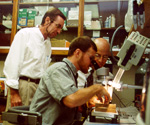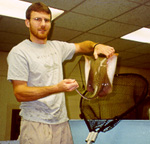From stingrays to kidneys
by Ann Lacy
Special to The Catalyst
So who says stingrays are of no value to mankind?
La raie au beurre noir? Stingray sauteed in brown butter? Quel delice! Ask any Frenchman.
Besides being a French seafood delicacy, these cartilagenous fish may prove to be extremely important to a scientific understanding of human kidney function.
 Wayne
Fitzgibbon and David Ploth look on as Janech describes a tissue specimen
taken from the kidney section of an Atlantic stingray.
Wayne
Fitzgibbon and David Ploth look on as Janech describes a tissue specimen
taken from the kidney section of an Atlantic stingray.
MUSC graduate student Mike Janech’s award-winning work in the field began in 1998 with the simple question, “How are local stingrays able to survive as they rapidly navigate from salt water into almost fresh water habitats?”
Tropical fish enthusiasts know the difficulty of setting up a saltwater aquarium relative to the ease of creating a habitat for freshwater guppies and angelfish. Most sea animals cannot live in fresh water, and even the slightest imbalance in the salt to water ratio in a saltwater aquarium will result in a lot of dead fish. Animals which can adapt to both seawater and freshwater are extremely rare and present unique opportunities to study the mechanisms that regulate the internal water balance.
 MUSC
marine biomedicine graduate student Mike Janech displays an Atlantic stingray,
the subject of his research into the kidney's response to changes in environmental
salinity.
MUSC
marine biomedicine graduate student Mike Janech displays an Atlantic stingray,
the subject of his research into the kidney's response to changes in environmental
salinity.
At the time, Janech, a student in the master’s program of the Grice Marine Laboratory, College of Charleston, was working with Donald Miller, Ph.D., of the Department of Pharmacology, MUSC. They approached David Ploth, M.D., and Wayne Fitzgibbon, Ph.D., from MUSC’s Division of Nephrology in the Department of Medicine with their question. This question intrigued Ploth, chair of the Nephrology Division. As a student, Ploth had worked with marine animals at the Mount Desert Island Biological Laboratory in Maine before devoting himself to medicine. As a clinician here at MUSC, his friendship with the late Donald DiBona, Ph.D., former director of Marine Biomedicine, further spurred his interest in marine science. Thus, to him the biological and medical significance of Janech’s question was obvious.
Janech’s study first focused on the role of the kidneys in the physiological response of the Atlantic stingray, Dasyatis sabina, to a decrease in environmental salinity. Atlantic stingrays are abundant in local waters and move from the ocean into the harbor and rivers, experiencing great changes in environmental salinity.
How could these animals rapidly and efficiently handle large changes in water intake that would induce a range of cardiovascular, renal and possible neurological problems in humans? As Ploth succinctly phrased the question, “How can stingrays live out there and survive up here?”
Janech, under the guidance of Wayne Fitzgibbon, an assistant professor in the Division of Nephrology, identified vascular access sites and adapted catheterization techniques to continuously allow the measurement of renal excretory function of stingrays in vivo.
Janech showed that in dilute seawater, the stingrays were able to increase kidney function so that they could excrete the large volume of water coming in across the gills. This ability to increase renal function is considerably greater than that of mammals and involves an increase in the amount of urea transported by the kidney tubules.
For his work on this project, Janech received the American Physiological Society’s Caroline Sum Tuden/ Francis A. Hillebrandt Professional Opportunity Award, an honor usually bestowed upon a doctoral student or post-doctoral fellow but in this case awarded to Janech while still at the masters degree level. In 2000, Janech also received the Council of Southern Graduate Schools Award for the most Distinguished Master’s Thesis.
While Janech’s initial study focused on basic kidney physiology, his doctoral work in the MUSC Marine Biomedicine Program, in collaboration with Ploth and Fitzgibbon, involves identifying the genetic sequences of the transporters involved in urea movement across the kidney tubules of the stingrays. Their goal is to determine the genetic basis for the mechanisms that result in urea transport changing so efficiently in the stingray as the animal goes from saltwater to freshwater.
“It’s as if the ray throws a switch when it changes environments,” Ploth explained. They found that the gene which encodes the proteins in the cell membranes of the renal tubular cells that transport urea into and out of the renal tubule is rapidly switched on or off in response to external salinity.
For identifying the genetic sequence of the stingray urea transporter molecules, Janech has been awarded the Carrier Award from the American Elasmobranch Society.
He has also received competitive travel awards from the International Union of Physiological Sciences and from the International Congress on the Biology of Fish to present his work at conferences in New Zealand and Canada.
Ploth emphasizes that this research, funded by Dialysis Clinics Inc. and the Veterans’ Administration, is relevant to our understanding of human renal function. It clarifies how our kidneys regulate our internal environment under different conditions of water and salt intake, a process known as osmoregulation.
As with other mammals, the human kidney is highly efficient at water conservation. However, it cannot regulate the body’s internal environment under conditions of continuous high water loads. In contrast, the stingray kidney has a remarkable ability to handle large water loads. Despite this difference in function, for both humans and stingrays the regulation of the transport of urea across the kidney tubules contributes to the maintenance of stable water content within the body.
While stressing the importance of this basic science research to our knowledge of renal function, Ploth can also foresee future applications of this knowledge to human health and well-being. A deeper knowledge of urea regulatory mechanisms may lead to a “completely new and different form of diuretics.”
Also, this work may result in new ways to treat water and electrolyte
disequilibrium syndromes and/or volume-dependent hypertension, Ploth said.
Catalyst Online is published weekly, updated as
needed and improved from time to time by the MUSC Office of Public Relations
for the faculty, employees and students of the Medical University of South
Carolina. Catalyst Online editor, Kim Draughn, can be reached at 792-4107
or by email, catalyst@musc.edu. Editorial copy can be submitted to Catalyst
Online and to The Catalyst in print by fax, 792-6723, or by email to petersnd@musc.edu
or catalyst@musc.edu. To place an ad in The Catalyst hardcopy, call Community
Press at 849-1778.